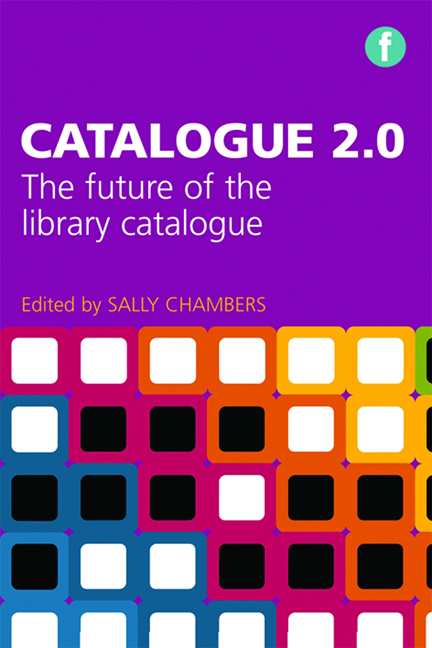Book contents
- Frontmatter
- Dedication
- Contents
- Acknowledgements
- Foreword
- Introduction
- Editor and contributor
- 1 Next-generation catalogues: what do users think?
- 2 Making search work for the library user
- 3 Next-generation discovery: an overview of the European scene
- 4 The mobile library catalogue
- 5 FRBRizing your catalogue: the facets of FRBR
- 6 Enabling your catalogue for the Semantic Web
- 7 Supporting digital scholarship: bibliographic control, library co-operatives and open access repositories
- 8 Thirteen ways of looking at libraries, discovery and the catalogue: scale, workflow, attention
- Index
Introduction
Published online by Cambridge University Press: 08 June 2018
- Frontmatter
- Dedication
- Contents
- Acknowledgements
- Foreword
- Introduction
- Editor and contributor
- 1 Next-generation catalogues: what do users think?
- 2 Making search work for the library user
- 3 Next-generation discovery: an overview of the European scene
- 4 The mobile library catalogue
- 5 FRBRizing your catalogue: the facets of FRBR
- 6 Enabling your catalogue for the Semantic Web
- 7 Supporting digital scholarship: bibliographic control, library co-operatives and open access repositories
- 8 Thirteen ways of looking at libraries, discovery and the catalogue: scale, workflow, attention
- Index
Summary
Does the library catalogue have a future? This is often the first question that people ask me when I tell them that I am editing a book on the future of the library catalogue. And, indeed, it is one of the key themes that we will explore in this book.
Until recently, the library catalogue has provided the key to unlocking the treasures of a library's collections. Without exploring the library catalogue, a user will not know which books are to be found in the library or, where they can be found.
In the last 25 years, the nature of the library catalogue has changed immensely. Even within my own working life as a librarian, I have seen library catalogues in many forms: the huge, heavy tomes of the printed versions of both the British Museum and Library of Congress catalogues; the wooden drawers filled with neatly ordered card catalogues; the first electronic library catalogues on small black screens with fluorescent green letters; the firstgeneration web OPACs; the federated search portals; the discovery systems; the mobile library catalogues; and, increasingly, the opening of Linked Data applications setting library bibliographic data free for use by other applications, outside the library, on the web.
Not only has the library catalogue changed, but cataloguing, the essential skill of bibliographic description and therefore of catalogue creation, is undergoing a steady evolution. One of the traditional tools of the cataloguing trade, the AngloAmerican Cataloguing Rules, 2nd edition (AACR2), a detailed set of rules telling librarians how books and other library materials need to be described for inclusion in the library catalogue, is expected, albeit over a period of several years, to be replaced by Resource Description and Access (RDA). RDA, the cataloguing standard for the 21st century, was published in June 2010 and following a thorough testing process in the United States, was due to be implemented by the Library of Congress from ‘RDA Implementation Day One’, 31 March 2013.
The development of RDA has not been the only recent historical event within the bibliographic universe. MARC, MAchine Readable Cataloguing, the standardized way of encoding bibliographic data, is in the process of being replaced by a newer webenabled standard
- Type
- Chapter
- Information
- Catalogue 2.0The future of the library catalogue, pp. xv - xxiiPublisher: FacetPrint publication year: 2013

